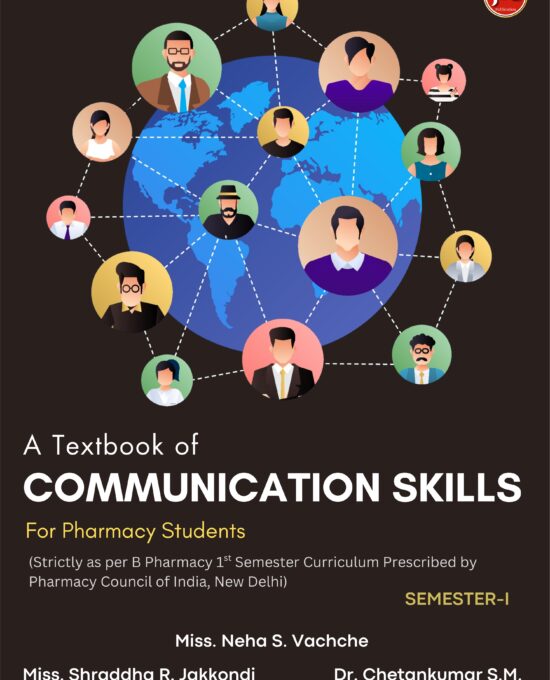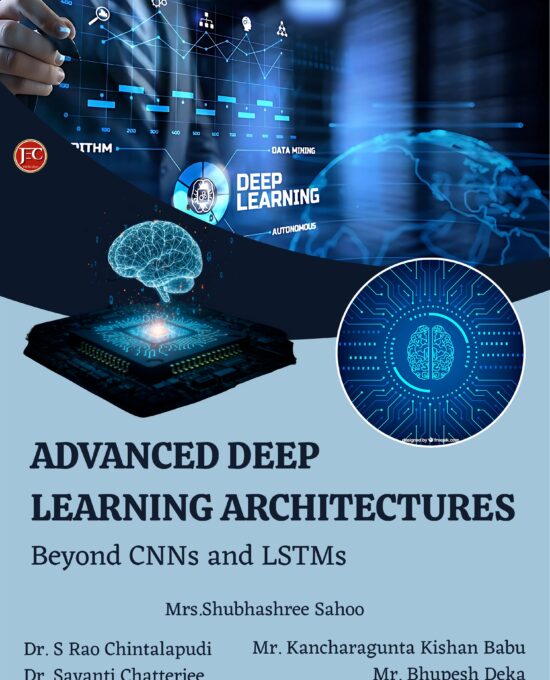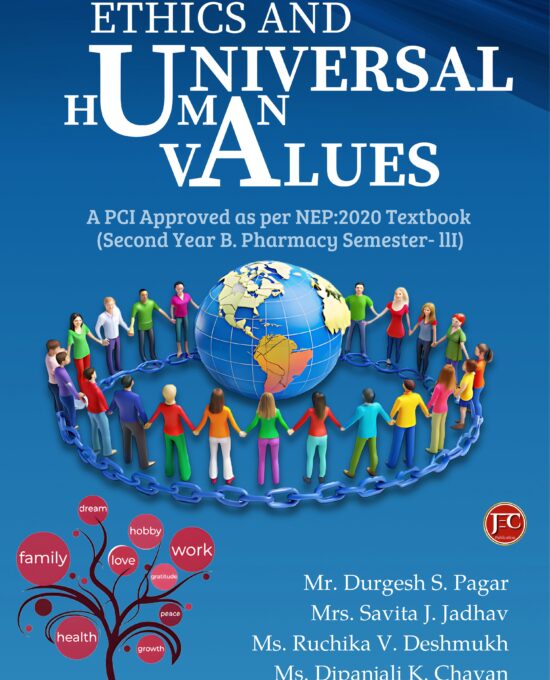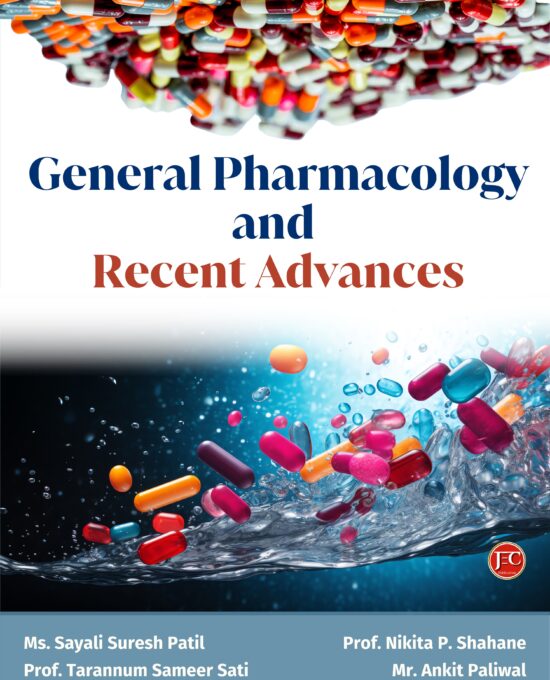A Textbook of COMMUNICATION SKILLS
₹499.00
A Textbook of Communication Skills for Pharmacy Students is designed to meet
the specific needs of budding pharmacists by equipping them with essential soft skills
required in professional healthcare settings. Communication is the foundation of
effective pharmacy practice, as pharmacists routinely interact with doctors, nurses,
dentists, physiotherapists, patients, and other healthcare professionals. This book
provides a clear, structured approach to developing the ability to convey information
confidently, accurately, and empathetically.
The content is carefully aligned with the Pharmacy Council of India’s BP105T
Communication Skills (Theory) syllabus, ensuring that students acquire not only
theoretical knowledge but also practical competence. Each unit systematically
introduces learners to the fundamentals of communication-covering verbal, nonverbal, and written communication-while also addressing barriers that may hinder
effective interactions.
Students will explore diverse aspects such as communication processes, listening
skills, and communication styles, alongside practical skills like interview techniques,
presentations, and group discussions. The book emphasizes both professional and
interpersonal dimensions, preparing students to become effective team players and
leaders in the pharmaceutical sector.
In addition, the text highlights the behavioural and attitudinal requirements of a
pharmacist, focusing on teamwork, leadership, empathy, and patient-centered
communication. Examples, illustrations, and simplified explanations make the
content easy to understand, while the inclusion of real-life applications encourages
students to practice and refine their skills.
Overall, this book aims to bridge the gap between knowledge and practice, helping
pharmacy students develop confidence, clarity, and professionalism in their
communication. By mastering these skills early in their academic journey, students
will be better prepared to contribute meaningfully to patient care, collaborative
healthcare teams, and the pharmaceutical business environment.
A Textbook of COMMUNICATION SKILLS
₹499.00
A Textbook of Communication Skills for Pharmacy Students is designed to meet
the specific needs of budding pharmacists by equipping them with essential soft skills
required in professional healthcare settings. Communication is the foundation of
effective pharmacy practice, as pharmacists routinely interact with doctors, nurses,
dentists, physiotherapists, patients, and other healthcare professionals. This book
provides a clear, structured approach to developing the ability to convey information
confidently, accurately, and empathetically.
The content is carefully aligned with the Pharmacy Council of India’s BP105T
Communication Skills (Theory) syllabus, ensuring that students acquire not only
theoretical knowledge but also practical competence. Each unit systematically
introduces learners to the fundamentals of communication-covering verbal, nonverbal, and written communication-while also addressing barriers that may hinder
effective interactions.
Students will explore diverse aspects such as communication processes, listening
skills, and communication styles, alongside practical skills like interview techniques,
presentations, and group discussions. The book emphasizes both professional and
interpersonal dimensions, preparing students to become effective team players and
leaders in the pharmaceutical sector.
In addition, the text highlights the behavioural and attitudinal requirements of a
pharmacist, focusing on teamwork, leadership, empathy, and patient-centered
communication. Examples, illustrations, and simplified explanations make the
content easy to understand, while the inclusion of real-life applications encourages
students to practice and refine their skills.
Overall, this book aims to bridge the gap between knowledge and practice, helping
pharmacy students develop confidence, clarity, and professionalism in their
communication. By mastering these skills early in their academic journey, students
will be better prepared to contribute meaningfully to patient care, collaborative
healthcare teams, and the pharmaceutical business environment.
ADVANCED DEEP LEARNING ARCHITECTURES Beyond CNNs and LSTMs
₹499.00
Deep learning has fundamentally transformed the landscape of artificial intelligence, powering
breakthroughs in computer vision, natural language processing, speech recognition, and beyond.
Over the past decade, Convolutional Neural Networks (CNNs) and Long Short-Term Memory
networks (LSTMs) emerged as the dominant architectures for tackling structured image data and
sequential information, respectively. CNNs, with their hierarchical feature extraction and local
receptive fields, revolutionized image classification, object detection, and semantic segmentation,
enabling systems to achieve near-human or even superhuman performance on benchmarks such
as ImageNet. LSTMs, on the other hand, overcame the limitations of traditional recurrent neural
networks, effectively addressing the vanishing gradient problem and enabling long-range
temporal dependencies to be learned, thereby advancing language modeling, machine translation,
and speech synthesis.
However, as datasets expanded to billions of samples, tasks grew increasingly complex, and the
need for generalization across heterogeneous domains intensified, the inherent limitations of
CNNs and LSTMs became apparent. CNNs struggle with modeling long-range dependencies,
processing irregular graph-structured data, or integrating multimodal inputs, while LSTMs face
challenges in parallelization, handling very long sequences efficiently, and scaling to massive
model sizes. Moreover, simply increasing depth, width, or training data does not always guarantee
proportional improvements in performance, highlighting the plateauing effect of these
architectures in cutting-edge AI applications.
This book, Advanced Deep Learning Architectures: Beyond CNNs and LSTMs, is designed to chart
the evolution of next-generation architectures that address these limitations and define the future
of artificial intelligence. It offers a comprehensive journey through the design principles,
mathematical foundations, and practical implementations of state-of-the-art models. The scope
spans transformers — including BERT, GPT, and Vision Transformers — which leverage selfattention to model long-range dependencies and multimodal relationships; graph neural networks,
which enable AI systems to reason about relational and non-Euclidean data; capsule networks,
which improve spatial hierarchies and pose awareness; neural ordinary differential equations,
which introduce continuous-time modeling; and diffusion models, which have redefined
generative AI through probabilistic modeling and denoising frameworks. The book also delves
into hybrid and multimodal architectures, advanced reinforcement learning frameworks, and
emerging paradigms such as neuromorphic computing, quantum deep learning, and evolutionary algorithms. Importantly, the text bridges theory and practice. Each chapter combines rigorous
mathematical derivations — from linear algebra and tensor calculus to probabilistic modeling and
information-theoretic analysis — with hands-on Python implementations using libraries such as
PyTorch, TensorFlow, and NumPy. Readers are guided through step-by-step coding exercises,
practical tips for optimization, and demonstrations of applying these models to real-world datasets.
This dual approach ensures a deep understanding not just of why these architectures work, but
how to implement, experiment, and extend them.
Beyond technical mastery, the book emphasizes the broader implications of advanced AI:
multimodal intelligence, ethical alignment, interpretability, and the path toward general-purpose
AI systems.
ADVANCED DEEP LEARNING ARCHITECTURES Beyond CNNs and LSTMs
₹499.00
Deep learning has fundamentally transformed the landscape of artificial intelligence, powering
breakthroughs in computer vision, natural language processing, speech recognition, and beyond.
Over the past decade, Convolutional Neural Networks (CNNs) and Long Short-Term Memory
networks (LSTMs) emerged as the dominant architectures for tackling structured image data and
sequential information, respectively. CNNs, with their hierarchical feature extraction and local
receptive fields, revolutionized image classification, object detection, and semantic segmentation,
enabling systems to achieve near-human or even superhuman performance on benchmarks such
as ImageNet. LSTMs, on the other hand, overcame the limitations of traditional recurrent neural
networks, effectively addressing the vanishing gradient problem and enabling long-range
temporal dependencies to be learned, thereby advancing language modeling, machine translation,
and speech synthesis.
However, as datasets expanded to billions of samples, tasks grew increasingly complex, and the
need for generalization across heterogeneous domains intensified, the inherent limitations of
CNNs and LSTMs became apparent. CNNs struggle with modeling long-range dependencies,
processing irregular graph-structured data, or integrating multimodal inputs, while LSTMs face
challenges in parallelization, handling very long sequences efficiently, and scaling to massive
model sizes. Moreover, simply increasing depth, width, or training data does not always guarantee
proportional improvements in performance, highlighting the plateauing effect of these
architectures in cutting-edge AI applications.
This book, Advanced Deep Learning Architectures: Beyond CNNs and LSTMs, is designed to chart
the evolution of next-generation architectures that address these limitations and define the future
of artificial intelligence. It offers a comprehensive journey through the design principles,
mathematical foundations, and practical implementations of state-of-the-art models. The scope
spans transformers — including BERT, GPT, and Vision Transformers — which leverage selfattention to model long-range dependencies and multimodal relationships; graph neural networks,
which enable AI systems to reason about relational and non-Euclidean data; capsule networks,
which improve spatial hierarchies and pose awareness; neural ordinary differential equations,
which introduce continuous-time modeling; and diffusion models, which have redefined
generative AI through probabilistic modeling and denoising frameworks. The book also delves
into hybrid and multimodal architectures, advanced reinforcement learning frameworks, and
emerging paradigms such as neuromorphic computing, quantum deep learning, and evolutionary algorithms. Importantly, the text bridges theory and practice. Each chapter combines rigorous
mathematical derivations — from linear algebra and tensor calculus to probabilistic modeling and
information-theoretic analysis — with hands-on Python implementations using libraries such as
PyTorch, TensorFlow, and NumPy. Readers are guided through step-by-step coding exercises,
practical tips for optimization, and demonstrations of applying these models to real-world datasets.
This dual approach ensures a deep understanding not just of why these architectures work, but
how to implement, experiment, and extend them.
Beyond technical mastery, the book emphasizes the broader implications of advanced AI:
multimodal intelligence, ethical alignment, interpretability, and the path toward general-purpose
AI systems.
ETHICS AND UNIVERSAL HUMAN VALUES
₹499.00
Ethics and universal values have always formed the foundation of human life and society. In the
present era of rapid scientific, technological, and social advancement, the importance of ethical
conduct and value-based living has become even more significant.
This book has been prepared with the aim of offering a comprehensive understanding of ethics and
universal values in both theoretical and practical dimensions. It seeks to serve as a guiding companion
not only for students and professionals but also for every reader who aspires to live a meaningful and
responsible life.
The subject of ethics is not confined to academic study alone; it touches every aspect of human
existence. Universal values such as truth, honesty, compassion, justice, respect, and responsibility
transcend boundaries of culture, religion, and geography. They act as a unifying force for humanity
and provide the moral compass needed to face the challenges of modern life. This book emphasizes
these eternal values and highlights their relevance in family, society, workplace, environment, and in
the global context.
The scope of the book extends from the philosophical foundations of ethics to the practical application
of values in daily decision-making. It is written in simple and accessible language to facilitate better
understanding and reflection.
Case studies, examples, and thought-provoking ideas have been included to connect concepts with
real-life situations. The work is aligned with the vision of value-based education as highlighted in the
National Education Policy (NEP 2020), aiming to strengthen moral clarity along with intellectual
growth.
This book has drawn inspiration from ancient wisdom traditions, modern philosophers, and
contemporary thinkers. It reflects an interdisciplinary perspective, enriched by insights from philosophy,
psychology, sociology, and spirituality. I owe deep gratitude to my teachers, mentors, colleagues, and
students whose constant encouragement and feedback have guided the preparation of this work.
It is my sincere hope that this book will help readers to reflect upon their own values, develop ethical
decision-making skills, and contribute towards building a harmonious society. By integrating ethical
principles with knowledge and action, we can collectively move towards a future that balances
material progress with inner growth, ensuring peace, justice, and universal brotherhood.
Mr. Durgesh Samadhan Pagar
Assistant Professor
Shreeshakti Shaikshnik Sanstha’s
Divine College of Pharmacy, Satana, Nashik. (Maharashtra)
ETHICS AND UNIVERSAL HUMAN VALUES
₹499.00
Ethics and universal values have always formed the foundation of human life and society. In the
present era of rapid scientific, technological, and social advancement, the importance of ethical
conduct and value-based living has become even more significant.
This book has been prepared with the aim of offering a comprehensive understanding of ethics and
universal values in both theoretical and practical dimensions. It seeks to serve as a guiding companion
not only for students and professionals but also for every reader who aspires to live a meaningful and
responsible life.
The subject of ethics is not confined to academic study alone; it touches every aspect of human
existence. Universal values such as truth, honesty, compassion, justice, respect, and responsibility
transcend boundaries of culture, religion, and geography. They act as a unifying force for humanity
and provide the moral compass needed to face the challenges of modern life. This book emphasizes
these eternal values and highlights their relevance in family, society, workplace, environment, and in
the global context.
The scope of the book extends from the philosophical foundations of ethics to the practical application
of values in daily decision-making. It is written in simple and accessible language to facilitate better
understanding and reflection.
Case studies, examples, and thought-provoking ideas have been included to connect concepts with
real-life situations. The work is aligned with the vision of value-based education as highlighted in the
National Education Policy (NEP 2020), aiming to strengthen moral clarity along with intellectual
growth.
This book has drawn inspiration from ancient wisdom traditions, modern philosophers, and
contemporary thinkers. It reflects an interdisciplinary perspective, enriched by insights from philosophy,
psychology, sociology, and spirituality. I owe deep gratitude to my teachers, mentors, colleagues, and
students whose constant encouragement and feedback have guided the preparation of this work.
It is my sincere hope that this book will help readers to reflect upon their own values, develop ethical
decision-making skills, and contribute towards building a harmonious society. By integrating ethical
principles with knowledge and action, we can collectively move towards a future that balances
material progress with inner growth, ensuring peace, justice, and universal brotherhood.
Mr. Durgesh Samadhan Pagar
Assistant Professor
Shreeshakti Shaikshnik Sanstha’s
Divine College of Pharmacy, Satana, Nashik. (Maharashtra)
PHARMACEUTICAL JURISPRUDENCE Principles, Laws and Regulations
₹499.00
Pharmacy students can better understand the rules that affect their profession and the larger
pharmaceutical business in India by studying pharmaceutical jurisprudence, which is the basic study
of the legal and regulatory frameworks governing pharmacy. With its clear, student-friendly
presentation of key statutory instruments like the Drugs and Cosmetics Act, the Pharmacy Act,
numerous pertinent regulations, and supplemental legislations like the IPR provisions.
This book is especially made to fit the updated syllabus of B. Pharmacy according to (NEP 2020) for
Semester VI which is established by the Pharmacy Council of India. The material is clearly structured
to support self-study and improve conceptual clarity through the use of images, tables, and chapterend questions, and it is divided into five units and thirty sections.
Each section's goal is communicated clearly to help readers grasp the learning objectives and make
sure they comprehend the legislative and practical ramifications of pharmaceutical law. The writers
sincerely thank the publishing team and their academic institutions for their steadfast support. Faculty,
librarians, and co-workers who provided resources and support during the book's preparation are
especially acknowledged. Readers, whether professionals, instructors, or students, are encouraged to
provide constructive criticism so that subsequent versions can be improved.
This book explains fundamental legal concepts in pharmaceutical practice, giving pharmacy
professionals and students the necessary legal knowledge to navigate regulatory compliance, protect
patient safety, and steer clear of legal pitfalls by presenting ethics and legislation in an understandable
and straightforward manner.
PHARMACEUTICAL JURISPRUDENCE Principles, Laws and Regulations
₹499.00
Pharmacy students can better understand the rules that affect their profession and the larger
pharmaceutical business in India by studying pharmaceutical jurisprudence, which is the basic study
of the legal and regulatory frameworks governing pharmacy. With its clear, student-friendly
presentation of key statutory instruments like the Drugs and Cosmetics Act, the Pharmacy Act,
numerous pertinent regulations, and supplemental legislations like the IPR provisions.
This book is especially made to fit the updated syllabus of B. Pharmacy according to (NEP 2020) for
Semester VI which is established by the Pharmacy Council of India. The material is clearly structured
to support self-study and improve conceptual clarity through the use of images, tables, and chapterend questions, and it is divided into five units and thirty sections.
Each section's goal is communicated clearly to help readers grasp the learning objectives and make
sure they comprehend the legislative and practical ramifications of pharmaceutical law. The writers
sincerely thank the publishing team and their academic institutions for their steadfast support. Faculty,
librarians, and co-workers who provided resources and support during the book's preparation are
especially acknowledged. Readers, whether professionals, instructors, or students, are encouraged to
provide constructive criticism so that subsequent versions can be improved.
This book explains fundamental legal concepts in pharmaceutical practice, giving pharmacy
professionals and students the necessary legal knowledge to navigate regulatory compliance, protect
patient safety, and steer clear of legal pitfalls by presenting ethics and legislation in an understandable
and straightforward manner.













